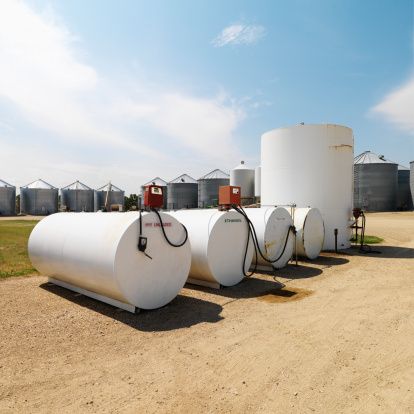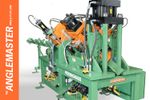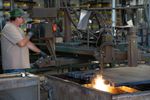Custom steel bulk storage tanks are, by definition, specified and built according to the particulars of their intended uses. This includes fabricating them with the required dimensions and features, but it also involves selecting a suitable grade of steel.
The steel used to create storage tanks falls into two main categories: carbon steel and stainless steel. Carbon steels can be divided into three main categories: low carbon steel, medium carbon steel, and high carbon steel. Stainless steel, on the other hand, can be grouped into five main types: austenitic, ferritic, martensitic, duplex, and precipitation.
Custom bulk storage tanks rarely make use of any of these grades except for low-carbon carbon steel — used for most applications — and the most common grade of austenitic stainless steel, 304 (although stainless grade 316 is also used on occasion). Carbon steel is preferred whenever possible because it is significantly less expensive than stainless.
Let’s take a closer look at these types of steel and the tanks that can be fabricated using them.
Metal Grades for Carbon Steel Tanks
Low-carbon, or mild, steel contains between 0.05% and 0.15% carbon. Because of this, it is quite malleable and can be easily bent, rolled, and welded into desired shapes. This flexible quality makes it easy to form the basic “disc and donut” assemblies that are used to create many finished storage tanks from carbon steel plates.
As a relatively inexpensive material that meets the requirements for most storage applications, mild carbon steel is a great choice for tanks designed for chemical, fuel, oil, and water storage. Depending on the material stored, carbon steel tanks can also be lined with different types of epoxy, polyurethane or rubber in order to prevent corrosion and leakage.
Some above-ground and below-ground steel bulk storage tanks used for storing flammable liquids, such as oil or petroleum, may also require double walls to protect the surrounding environment from potential leaks.
Metal Grades for Stainless Steel Storage Tanks
When it comes to storing chemicals that aren’t compatible with carbon steel or that are too corrosive for any linings added to carbon steel tanks, non-reactive stainless steel tanks are recommended and often required. Stainless steel is distinguished from carbon steel by its chromium content, which makes it resistant to tarnishing and rust.
304 & 304L Stainless Steel Storage Tanks
Grade 304 stainless steel — also known as “18/8” because of its 18% chromium, 8% nickel content — is the most common grade of stainless steel. It is used to manufacture everyday objects such as pots and pans, sinks, and kitchen appliances and is also the most common type of stainless steel used in industrial tank fabrication. Tanks fabricated from 304 stainless can be used to house glycerin and liquid fertilizer and 304 is also used to fabricate pasteurizing and maturation tanks.
Grade 304L stainless steel is a low-carbon variation on 304. While a little more expensive, it’s the preferred material for large stainless steel storage tanks that require a lot of welds. The low carbon content mitigates against the formation of chrome carbide precipitation (CCP) in the areas adjacent to the welds, which reduces the chance of the tank rusting in those spots.
Food-Grade Stainless Steel Tanks
Food-grade stainless steel is usually 304 stainless that has been given a sanitary finish so that it can be easily cleaned and so that it will resist the growth of bacteria on its surface.
As defined by the federal government, a food-grade finish must be smooth to the point that it does not have any lines, grooves, pits, or any other surface irregularities. It must also be corrosion resistant, maintaining its integrity in the face of the food placed on it and the chemicals used to clean it.
Stainless steel can be given a food-grade finish by grinding and sanding it. While a No. 3 finish is passable in some cases, it’s common practice to give stainless steel meant for food-related applications a No. 4 “brushed” finish. Bulk storage anks designed for milk and other dairy products should have a slightly finer finish — No. 4A — since they tend to carry more bacteria and spoil faster than other food products.
316 Stainless Steel Tanks
After grade 304, grade 316 is the most common form of stainless steel. In addition to chromium, it includes some molybdenum content — generally 2–3%.
The inclusion of molybdenum makes 316-stainless steel more resistant to corrosion than 304. In particular, 316 stainless is known for its capacity to resist sulfuric acid and the heated organic fatty acids involved in certain food processing and pharmaceutical applications. It should be noted, though, that there is a definite exception to this acid-resistance rule of thumb — 316 is more vulnerable than 304 to nitric acid and other highly oxidizing acids.
Many marine applications use of 316-stainless steel because it resists salt-water corrosion. For this reason, it is sometimes referred to as “marine-grade stainless steel.”
Like 304, 316 also has an “L” counterpart — 316L stainless. Similar to 304L, 316L is a low-carbon variant recommended for large products with a substantial number of welds.
Custom Steel Tanks
In this article, we’ve provided an overview of the most common grades of steel used to fabricate storage tanks. As noted at the outset, there are many other categories of steel with many variations within them. Theoretically, any type of steel could be used to fabricate a custom bulk storage tank. The grade that best suits your application will ultimately depend on the material you plan to store and the conditions in which you will store it.
When you work with a custom metal fabricator to design and build an industrial storage tank, you get to choose the material that best fits your conditions, as well as specify the size and fittings. Often, this level of customization can make all the difference. Not only are particular types of steel required in some cases, but fabricating a custom tank to fit your material and environmental requirements will result in a better, longer-lasting product.
If you have any questions about custom tanks or are still wondering which grade of steel you should be using for your storage tank application, please don’t hesitate to contact us.





